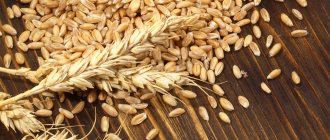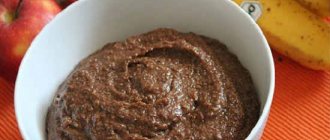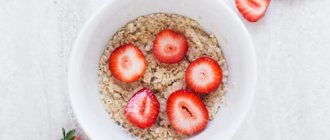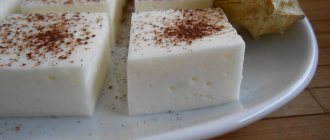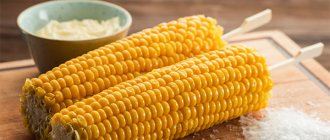Burrata cheese (buratto) is a combination of the well-known mozzarella with the most delicate cream. An authentic product in Italy is prepared from fresh buffalo milk. And it has many useful properties.
Photo: Depositphotos.com. Author: karissaa.
It is believed that this fresh semi-hard cheese was first made either in the Italian province of Murgia or in Angria approximately in 1920–1930.
Subtleties of production
Real burrata is made exclusively from Mediterranean buffalo milk and is based on flexible mozzarella.
- It is prepared using traditional technology: fresh cottage cheese is kept in hot water or whey for several hours, after which it is kneaded to the desired viscosity.
- Then a bag is formed from the resulting mass.
- The cavity is filled with cream mixed with grated or chopped into small pieces mozzarella (stracciatella).
- The bag is closed and tied with asphodel leaves.
By the way, outside of Italy, burrata is most often made from regular cow's milk.
Food-list
In fact, the famous Italian Burata cheese is called Burrata or Burrata and is listed as one of the most famous delicacies among Italian fresh cheeses. However, when translated into Russian, the name of the cheese has undergone some changes and domestic gourmets know this type of cheese, made from buffalo milk and cow milk, as Burata.
In Italy, Burata cheese belongs to the group of so-called fibrous cheeses or pasta filata. Italian cheese makers began producing Burata cheese about a hundred years ago. However, even such a short period by the standards of cheese making was enough for Burata cheese to take its rightful place in the galaxy of first-class cheeses of Italian origin.
Fresh brine Burata cheese resembles another equally famous mozzarella cheese in its appearance. However, Burata cheese has an even more delicate texture and creamy taste. It is interesting that the cream that makes up the filling of burata cheese is stracciatella made from cream and pieces of mozzarella.
Burata cheese is distinguished not only by its appearance, but also by its size, which is quite small for cheeses. On average, Burata cheese weighs no more than 700 grams. The cheese is often called Burratina due to its miniature size. The process of making Burrata cheese is completed with special attention. Burrata cheese is a hybrid or symbiosis of mozzarella cheese and cream.
Cheesemakers still couldn't figure out how to use the pieces of mozzarella that remain during the cheese production process. As a result, the mozzarella pieces were crushed and mixed with cream, and then placed in a bag made from cheese dough and wrapped in banana leaves like packaging. It is worth noting that for quite a long time, the cheese makers of the Andria region carefully protected the recipe for Burata cheese.
However, over time, fame about the amazing taste of the new type of cheese spread throughout Italy, and then throughout Europe. It is noteworthy that Burrata cheese spoils quite quickly, so the product is best eaten freshly prepared. The cheese goes perfectly with tomatoes, as well as olive oil and ground black pepper.
The surprisingly delicate taste of Burata cheese is often used in Mediterranean recipes. It is worth noting that Buratta cheese is good both as an independent snack and as an ingredient in culinary products. As a rule, Buratta cheese is used in the preparation of salads with fresh herbs, vegetables and olive oil.
Gourmets and experts in the Italian cheese-making tradition claim that Burata cheese reveals its magnificent taste after the product has been left at room temperature for some time. Therefore, before serving, it is better to take Buratta cheese out of the refrigerator so that the product can give all the fullness of taste and aroma.
The nutritional value
BJU product (per 100 g):
- It is a rich source of protein (17.8 g), including all essential amino acids.
- It is characterized by an increased concentration of fat (up to 25 g), of which up to 15 g is saturated fat, including 70–90 mg of cholesterol.
- Carbohydrates are contained in trace amounts (with the exception of burrata, which has added sugar to the filling).
Vitamins: A (714–800 IU per 100 g), E, K, group B (B1, B2, B3, B4).
Macro- and microelements (per 100 g): calcium (536 mg), phosphorus (354 mg), potassium and sodium (214-317 mg).
Nutritional value and beneficial properties
Buratta, like any cheese product, is healthy for humans. It consists only of natural ingredients. The only contraindication for the Italian product is that it should not be consumed by people with lactose intolerance.
The classic recipe uses milk, cream and sourdough. This product is not stored for long and is served only warm - it does not contain preservatives or thickeners. It contains calcium, phosphorus and other microelements that are beneficial to humans.
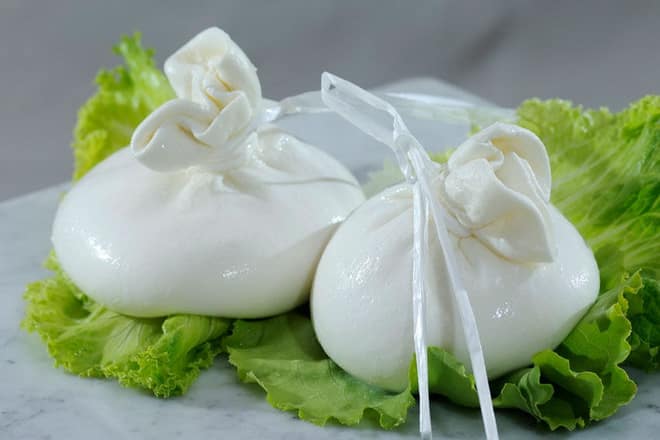
The product is useful for adults and children due to its balanced composition. What does it include:
- Choline. 100 g of fresh product contains at least 15 mg of a substance such as choline. It restores metabolic processes in the human body and strengthens the walls of blood vessels. This component helps normalize heart rate. It helps lower blood cholesterol levels.
- Retinol. The substance of beauty and youth - retinol, is found in large quantities in 100 g of cheese. It slows down the growth of bad cells and stimulates the regeneration process. Retinol helps improve the functioning of the visual system.
- Phosphorus. 100 g of Burrata contains up to 600 mg of phosphorus. This component is a building material for the skeletal system. Phosphorus is involved in many biochemical reactions in the human body. 100 g of cheese contains the daily requirement of phosphorus for an adult.
- Calcium. An indispensable component for a healthy body, calcium, is also found in Burrata. Its portion is almost 200 mg. It strengthens the teeth and bone skeleton of a person. Calcium is one of the most important components of growth for teenagers and children. Lack of calcium in the body leads to the development of rickets and other dangerous diseases.
- Sodium. Thanks to the sodium in Burrata, blood pressure stabilizes in the human body. Sodium helps improve the functioning of the gastrointestinal tract. It starts regeneration processes and allows you to maintain youthful skin.
The calorie content of the fresh product is 330 kcal. Ratio of proteins, fats and carbohydrates: 23%, 26% and 0%.
Calorie content
Burrata has a high energy value: 350 kcal per 100 g.
| Type of Italian cheese | Kcal per 100 g |
| Ricotta | 174 |
| Caciocavallo | 209 |
| Mozzarella | 240 |
| Scamorza | 244 |
| Gorgonzola | 330 |
| Burrata | 350 |
| Provolone | 351 |
| Fontina | 389 |
| Parmesan | 392 |
| Mascarpone | 412 |
| Pecorino | 419 |
What's the use
- Good for the brain. Thanks to the increased concentration of complete protein, including all essential amino acids (AA), the product ensures the normal functioning of the central nervous system (CNS), nourishes brain cells, and has a positive effect on cognitive functions, including improving memory.
- Valuable for the psyche. Being a valuable source of protein, burrata not only helps maintain muscle tone, but also stimulates the synthesis of neurotransmitters (biologically active substances necessary for the transmission of nerve impulses) in the brain. This has a positive effect on your mood and disperses the blues.
- Optimizes sleep. All the same mechanisms of protein metabolism in which the product participates ensure healthy sleep and easy falling asleep at the end of a busy day.
- Regulates appetite. It is no secret that protein diets are quite effective precisely because the human body continues to receive important nutrients even with strict dietary restrictions. Thanks to the increased concentration of protein, this Italian cheese is able to regulate appetite and suppress hunger.
- Strengthens teeth and bones. Being a source of calcium, this Italian cheese is good for teeth and bones. It strengthens their structure and prevents premature destruction.
- Normalizes digestion. Due to the increased phosphorus content, the product has a beneficial effect on the gastrointestinal tract (GIT).
- Regulates blood pressure due to the presence of potassium. Also, this macronutrient has a positive effect on the cardiovascular system as a whole, preventing disruptions in its functioning.
- Supports vision. Burrata contains a lot of vitamin A, which nourishes the visual organs and prevents eye diseases.
- Gives skin health and radiance. While beauties around the world take synthetic vitamin A and E complexes to look their best, Italian cheese with a creamy center promises the same effect.
- It exhibits probiotic properties due to the presence of beneficial bacterial cultures in the composition, which are used during milk ripening. These probiotics populate the intestines with friendly microflora, improve digestion, absorption of vitamins and minerals, and strengthen the immune system.
- Increases the absorption of fat-soluble vitamins A, D, E and K due to the increased fat content in the cheese “bag” and creamy filling.
Other beneficial effects:
- normalizes metabolism;
- is a source of quick energy due to the high proportion of proteins;
- prevents some cancers;
- prevents osteoporosis;
- reduces stress levels;
- normalizes kidney activity;
- ensures healthy functioning of the thyroid gland.
Application
Burata, like a creamy soft cheese, goes well with vegetables and black pepper. Perfect for making light but nutritious vegetable salads. Recommended for those who are on a diet, but in small quantities and for consumption in the first half of the day. Before serving, gourmets leave it at room temperature for about an hour, arguing that slightly warm cheese releases much more of its taste and aroma. Burata cheese is traditionally used in preparing Mediterranean dishes. On rare occasions, it is eaten for breakfast simply with a piece of grain bread and a drop of olive oil to add a special taste.
Market Analytics
- COVID-19 is changing the rules of the game in the cosmetics market
- Beauty of the future: cosmetic innovations 2020
- New ingredients are the driving force of the cosmetics industry
Convenient search for beauty salons on our website
Beauty salons in Moscow Beauty salons in St. Petersburg Beauty salons in Ekaterinburg Beauty salons in Novosibirsk
Latest blog posts on our website
- Naturecream / Geranium (Pelargonium) oil for skin health and beauty
- Prostye-sovety / Save on a beauty salon: procedures that can be done at home
- Naturecream / Growth Factor - brings back youth?
- Oksana-Lezina / 3 effective abdominal exercises from a fitness instructor for beginners
- Prostye-sovety / Making perfect curls at home
- Prostye-sovety / Which hair removal method to choose
- Naturecream / Wrinkles Puppets
- Naturecream / PEPHA-TIGHT - instant skin lifting
- Naturecream / Blue light - a danger to the skin
- Naturecream / Cocoa Butter – A treat for the skin
Latest forum topics on our website
- Mrs._Smith / Badly sunburned! What to do?((
- Ice / Is it necessary to combine fitness classes with a diet?
- Antonova / What can be used for hair loss?
- Radio operatorKat / Who was on a protein diet?
- Suzanna / Mesotherapy on the face
Other articles in this section
| Milk Milk is a nutritious animal product. Animal milk has been used by humans in their diet since ancient times. And in Hinduism, a religion widespread in India and some other countries, a cow that gives milk is considered a sacred animal. She is allowed to walk along any street, even the biggest city. |
| Manchego cheese Manchego cheese is a Spanish cheese made from pasteurized sheep's milk. The birthplace of this product is the La Mancha region of Spain. Manchego cheese matures over a period of three to six months and has a fairly firm texture, rich aroma and golden color. There are small holes in the cheese pulp. |
| Buttermilk 0.5% Buttermilk is a low-calorie dairy product considered a by-product during the butter extraction process. Previously, to make fresh milk, it was necessary to thoroughly whisk it for a long time to obtain butter, and the liquid that remained was buttermilk. Buttermilk can have minimal fat content - only 0.5%. This is achieved by turning all the fat from the milk into butter. |
| Cheese Dzhugas Dzhugas belongs to the group of Parmesan cheeses. It is made in Lithuania, following all the rules and technologies. It is also necessary to pay attention to the fact that Djugas cheese is aged for more than 3 months - this is a special pride of Lithuanian companies. There are also varieties of Dzhugas cheese, depending on the period of its aging during preparation - 12, 18, 24, 36 and 48 months. The color of the cheese also depends on the aging period - it can vary from light yellow to amber-orange. The structure of the cheese becomes hard and grainy. |
| Skimmed milk powder Even children know the benefits of milk. After all, it actually has valuable properties that have an excellent effect on the body. Almost every person around the world consumes milk every day. This drink is rich in vitamins and essential minerals that cannot be found in other products and substitutes. It is for this reason that it occupies a leading position in consumption. |
| Reblochon cheese Reblochon cheese is a soft cheese with a special rind called “washed”. It is made from the highest quality milk with a high percentage of fat content. The production technology of Reblochon cheese is based on its pressing and subsequent repeated washing using a specially created brine. This type of cheese matures within 2-4 weeks. |
| Feta Cheese Feta cheese is the national Greek cheese and is white in color. Sheep or goat milk is used to make it (the first option is the most common). |
| Low-fat soy milk Soy milk is made from soybeans. As history tells, this drink first appeared before our era in China. As the legend goes, soy milk was created by the philosopher Liu An. He created it so his mother could taste what soybeans tasted like (she couldn't chew them because she didn't have teeth). |
| Homemade Cheese Homemade cheese is valued only because it is prepared without preservatives and chemical additives. It is very useful for its nutrients. It cannot even be compared with those cheeses that are sold in stores. A person who makes cheese for his own consumption will not add harmful substances to it. |
| Sour cream 40% (fat) Sour cream is a product of Slavic origin. It is considered a traditional product among these peoples. People began to notice that a thick layer formed on the surface of the milk, which had a pleasant taste and thick consistency. Later, people learned to make sour cream from this consistency. For the first time this product was made in the village. Sour cream came to Europe quite late and it was called “Russian cream”. But in many countries even now sour cream is not produced. But in Russia, this product is an integral part of not only dinner or lunch, but also breakfast. Sour cream gives first courses a unique taste; it also refreshes the taste of vegetable salads and makes them more nutritious. |
What's the harm?
With frequent consumption of burrato cheese, the following side effects are possible, explained by the presence of a large amount of fat (including cholesterol) and lactose in the composition:
- weight gain, obesity;
- increased risk of heart disease and diabetes;
- metabolic disorders and indigestion.
Attention! In people suffering from lactose (milk sugar) intolerance, this fresh cheese can cause bloating, belching, flatulence, and diarrhea.
Contraindications to the use of burrata are not strict, but in the following cases it is necessary to greatly limit the presence of this product in the diet:
- diabetes;
- obesity;
- atherosclerosis;
- lactose intolerance (restrictions depend on the individual reaction of the body);
- heart and vascular diseases;
- acid reflux in the chronic stage;
- gastritis.
Attention! For the listed groups of people, the maximum daily dose of cheese is no more than 30 g, and not in the evening. Eating burrata before bed is not recommended at all.
Is it possible for pregnant women
Real burrata is made from pasteurized milk. Moreover, during the production process, the product goes through fermentation with enzymes and repeated soaking in boiling water.
The claim that this cheese does not undergo heat treatment, and therefore may contain bacteria of the genus Listeria (lat. Listeria), which is dangerous during pregnancy, is unfounded.
If you follow the cooking technology, burrata (in reasonable quantities, of course) is safe during pregnancy. Except in cases of individual intolerance.
Properties of burata cheese
How much does burata cheese cost (average price for 1 piece)?
Moscow and Moscow region.
560 rub.
In fact, the famous Italian Burata cheese is called Burrata or Burrata and is listed as one of the most famous delicacies among Italian fresh cheeses. However, when translated into Russian, the name of the cheese has undergone some changes and domestic gourmets know this type of cheese, made from buffalo milk and cow milk, as Burata.
In Italy, Burata cheese belongs to the group of so-called fibrous cheeses or pasta filata. Italian cheese makers began producing Burata cheese about a hundred years ago. However, even such a short period by the standards of cheese making was enough for Burata cheese to take its rightful place in the galaxy of first-class cheeses of Italian origin.
Fresh brine Burata cheese resembles another equally famous mozzarella cheese in its appearance. However, Burata cheese has an even more delicate texture and creamy taste. It is interesting that the cream that makes up the filling of burata cheese is stracciatella made from cream and pieces of mozzarella.
Burata cheese is distinguished not only by its appearance, but also by its size, which is quite small for cheeses. On average, Burata cheese weighs no more than 700 grams. The cheese is often called Burratina due to its miniature size. The process of making Burrata cheese is completed with special attention. Burrata cheese is a hybrid or symbiosis of mozzarella cheese and cream.
Cheesemakers still couldn't figure out how to use the pieces of mozzarella that remain during the cheese production process. As a result, the mozzarella pieces were crushed and mixed with cream, and then placed in a bag made from cheese dough and wrapped in banana leaves like packaging. It is worth noting that for quite a long time, the cheese makers of the Andria region carefully protected the recipe for Burata cheese.
However, over time, fame about the amazing taste of the new type of cheese spread throughout Italy, and then throughout Europe. It is noteworthy that Burrata cheese spoils quite quickly, so the product is best eaten freshly prepared. The cheese goes perfectly with tomatoes, as well as olive oil and ground black pepper.
The surprisingly delicate taste of Burata cheese is often used in Mediterranean recipes. It is worth noting that Buratta cheese is good both as an independent snack and as an ingredient in culinary products. As a rule, Buratta cheese is used in the preparation of salads with fresh herbs, vegetables and olive oil.
Gourmets and experts in the Italian cheese-making tradition claim that Burata cheese reveals its magnificent taste after the product has been left at room temperature for some time. Therefore, before serving, it is better to take Buratta cheese out of the refrigerator so that the product can give all the fullness of taste and aroma.
Culinary certificate

Photo: Sigaeva O.
This masterpiece of Italian cheesemaking goes perfectly with crusty bread, lettuce leaves and, of course, pasta.
Options for serving burrata in its native Italy take into account its compatibility with the following products:
- boiled eggs;
- prosciutto;
- tomatoes (fresh or grilled);
- fresh figs;
- caramelized peaches and nectarines;
- melon;
- artichoke;
- asparagus;
- grilled zucchini, eggplant and sweet peppers;
- beet;
- pistachios;
- roasted almonds;
- roasted walnuts;
- arugula;
- endive;
- radicchio salad;
- basil;
- ground pepper;
- balsamic vinegar;
- olive oil.
Shelf life
Ideally, burrata should be eaten within 1-2 days of making, and the general refrigerator shelf life of fresh cheese is only 3-4 days.
But the product reaches our shelves mainly in brine. Table salt extends shelf life and makes long-distance transportation possible. An opened package of pickled cheese can be kept in the refrigerator for up to 1 week.
On a note. Authentic burrata is tied with asphodel leaves. In addition to aesthetic functions, they serve as a kind of indicator of the freshness of the product. Withered leaves indicate that you were served cheese that was not the freshest.

